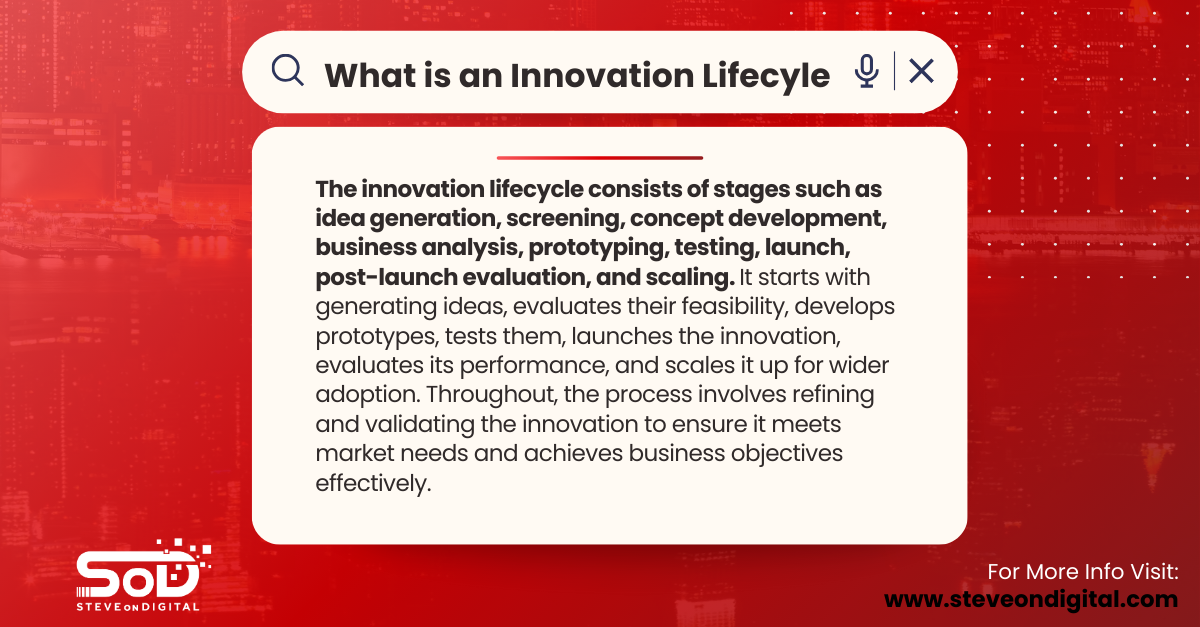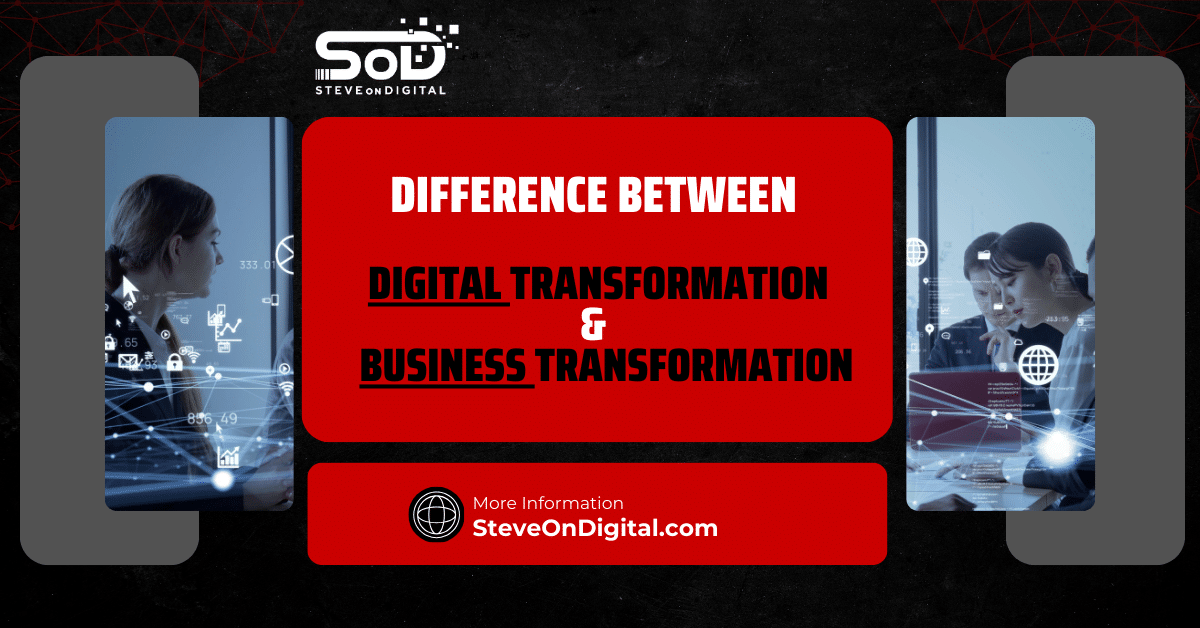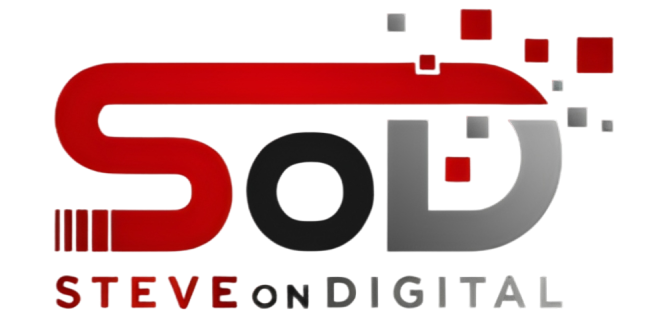Hello, Steve Johnston here, the heart and soul behind SteveOnDigital.
With my rich background in electrical engineering, an MBA, and a master’s in Project Management, I’ve dedicated my career to guiding small and medium-sized businesses through the complexities of digital transformation.
Today, I’m diving into a topic that’s close to my heart and critical to our future: “What Is Innovation Lifecycle?”
In the ever-evolving world of business and technology, understanding the innovation lifecycle is not just beneficial; it’s essential.
This concept isn’t merely academic—it’s the backbone of how new ideas flourish, from inception to implementation, shaping our industries and daily lives.
This article aims to unravel the layers of the innovation lifecycle, demystifying how it functions and why it’s a linchpin in achieving successful innovation.
We’ll start with a basic understanding, move through a detailed comparison with similar concepts, and finally discuss its significance.
By the end of this journey, you’ll not only grasp what the innovation lifecycle is but also why it’s indispensable in today’s fast-paced world.
Part 1: Understanding The Innovation Lifecycle
Definition And Explanation Of The Innovation Lifecycle
At its core, the innovation lifecycle is a framework that outlines the journey of an idea from its genesis to its realization and beyond.
It encapsulates several stages—idea generation, market analysis, development, and implementation—each crucial in transforming a spark of creativity into tangible, impactful innovation.
This lifecycle isn’t linear; it’s a cyclical process that fosters continuous improvement and adaptation, ensuring ideas are not just created but are viable, relevant, and successful.
Drawing from my experiences, I’ve seen firsthand how aligning with the innovation lifecycle can pivot a business from stagnation to growth.
It’s not just about having a groundbreaking idea; it’s about meticulously nurturing that idea through each phase of the lifecycle, ensuring it’s robust, well-researched, and market-ready.
| Stage | Objective | Key Activities |
| Idea Generation | Foster creativity and gather viable ideas | Brainstorming, cross-functional workshops, idea incubation programs |
| Market Analysis | Understand market needs and validate the idea | Market research, SWOT analysis, customer interviews |
| Development and Testing | Turn ideas into tangible solutions and validate with users | Prototyping, agile development, user testing |
| Implementation and Market Introduction | Launch the product and gain market traction | Marketing strategy, product launch, market feedback analysis |
Comparison With The Innovation Process, Innovation Life Cycle, And Innovation Cycle
While these terms might seem interchangeable at first glance, they offer nuanced perspectives on innovation:
- Innovation Process: Focuses on the steps involved in creating and implementing an idea. It’s more about the “how” of turning an idea into a solution.
- Innovation Life Cycle: Emphasizes the stages an innovation goes through, from inception to decline. It highlights the temporal aspect of innovation, suggesting an eventual phasing out as new innovations arise.
- Innovation Cycle: Often used synonymously with the innovation lifecycle, it underscores the repetitive nature of innovation—how new ideas are continuously born out of existing ones.
Each perspective offers valuable insights, but understanding innovation as a lifecycle underscores the importance of revisiting and refining ideas, adapting to market feedback, and evolving with technological advancements.
It’s a holistic view that encompasses not just the creation of innovations but their sustained development and maturation over time.
The Significance Of Viewing Innovation As A Lifecycle for Successful Innovation
Viewing innovation through the lens of a lifecycle is transformative.
It shifts the focus from one-time successes to ongoing growth, encouraging businesses to cultivate a culture of continuous innovation.
This perspective is vital for several reasons:
- Adaptability: In a world where market conditions and consumer preferences change at breakneck speed, the ability to adapt is paramount. The innovation lifecycle promotes a flexible approach, enabling businesses to pivot as needed.
- Sustainability: By focusing on the entire lifecycle, companies can ensure their innovations have a lasting impact, contributing to long-term success rather than short-lived triumphs.
- Competitive Edge: Understanding and leveraging the full innovation lifecycle can give businesses a significant advantage, allowing them to stay ahead of the curve and meet evolving customer needs more effectively.
The Stages Of The Innovation Lifecycle
The innovation lifecycle is not a mere sequence of steps; it’s a dynamic journey that an idea traverses to become a reality.
This journey is marked by four key stages, each serving a distinct purpose and requiring specific strategies for success.
1. Idea Generation
The genesis of innovation lies in idea generation.
This stage is all about fostering creativity and encouraging the free flow of ideas within the team.
It’s crucial to create an environment where team members feel empowered to share their thoughts, no matter how outlandish they may seem.

Techniques such as brainstorming sessions, idea incubators, and encouraging cross-functional collaborations have been instrumental in my experiences with generating viable ideas.
Enhance Idea Generation:
- Encourage open communication and brainstorming sessions.
- Utilize cross-functional teams to bring diverse perspectives.
- Implement idea incubation programs to nurture potential innovations.
2. Market Analysis
Following the burst of creativity, market analysis grounds the process by aligning ideas with customer needs and market demand.
This stage involves rigorous research to identify not only the potential market size but also the early adopters and the early majority who will be pivotal in the initial uptake of the innovation.
Understanding the competitive landscape is equally important, as it shapes the strategy for differentiation and positioning.
Key Aspects Of Market Analysis:
- Conduct surveys and focus groups to understand customer needs.
- Analyze market trends and identify potential gaps.
- Evaluate competitors to carve out a unique market position.
3. Development And Testing
Transitioning from an abstract idea to an actual solution, the development and testing phase is where concepts are brought to life.
This stage is characterized by designing, prototyping, and refining the product or service.
It’s a phase marked by both excitement and challenges, as the team works to translate ideas into functional, market-ready solutions.
Access to adequate resources, both human and technical, is crucial here.
My approach has always been to embrace iterative development, encouraging feedback from potential users and stakeholders to refine the product continuously.
Strategies For Effective Development And Testing:
- Adopt agile development methodologies for flexibility and speed.
- Engage in continuous testing with target users for real-time feedback.
- Ensure cross-departmental collaboration for a well-rounded development process.
4. Implementation And Market Introduction
The final hurdle before an innovation meets its audience is implementation and market introduction.
This stage is about more than just launching a product; it’s about strategically introducing it to the market to ensure maximum impact.
Timing, marketing strategy, and understanding the adoption phases (early majority, late majority) play critical roles in this phase.
Speed to market is essential but so is ensuring that the product meets the customer needs identified in the market analysis stage.
Leveraging digital marketing, engaging with influencers who resonate with early adopters, and continuous monitoring of market response are part of my arsenal for successful market introduction.
Tips For Successful Implementation And Market Introduction:
- Leverage social media and digital marketing for broader reach.
- Partner with influencers and early adopters to create buzz.
- Monitor market response closely and be ready to pivot strategy as needed.
Navigating through these stages requires not just a robust understanding of the process but also the agility to adapt as each stage presents its own set of challenges and opportunities.
My experiences have taught me that each phase of the innovation lifecycle is interconnected; success in one stage builds the foundation for success in the next.
Part 3: Critical Factors For Successful Innovation
Innovation is not a serendipitous event; it’s a complex process that requires strategic foresight and meticulous planning.
Through my experiences, I’ve identified several key factors that are instrumental in navigating the innovation lifecycle successfully:
Team Expertise
The foundation of any successful innovation is the team behind it.
A diverse team with a broad spectrum of skills and expertise is crucial.
It’s not just about having the technical know-how; understanding market trends, customer psychology, and business strategy plays an equally important role.
- Why it matters: A multifaceted team can approach problems from different angles, leading to more creative and effective solutions.
Focus On Customer Needs
Innovation must solve a real problem or fulfill a need for the customers.
Engaging with your target audience early and often ensures that the innovation remains relevant and desirable.

Keeping Customer Focus:
- Regularly conduct customer interviews and surveys.
- Use social media and forums to gauge customer interests and pain points.
- Prototype early and seek feedback from potential users.
Continuous Research And Development (R&D)
The world is constantly changing, with new technologies and methodologies emerging at a rapid pace.
Staying committed to ongoing R&D helps in keeping the innovation process agile and responsive to these changes.
- Key insight: Allocate resources for R&D even after the initial product launch to ensure continuous improvement and adaptation to market demands.
Feedback Loops
Feedback loops are essential mechanisms within the innovation lifecycle.
They allow for continuous refinement and improvement of the innovation based on real-world usage and feedback.
- Real-world application: Use beta testing phases and pilot programs to collect detailed feedback from early adopters.
Business Case Development
Developing a robust business case for the innovation ensures that it’s not just technically viable but also commercially feasible.
It helps in securing the necessary buy-in from stakeholders and investors.
Strategies For Success:
- Clearly articulate the value proposition of the innovation.
- Conduct a thorough market analysis to support the business case.
- Outline the financial model, including cost, pricing strategies, and ROI projections.
Engaging With Stakeholders
Innovation doesn’t happen in isolation.
Engaging with all relevant stakeholders – from team members to partners, customers, and investors – is crucial for gaining diverse perspectives and securing the support needed for success.
- Tip: Regular update meetings and open communication channels keep stakeholders informed and engaged.
Part 4: Innovation Lifecycle In Practice
Theory is vital, but it’s the practical application of these principles that brings innovation to life.
Let me share some real-life examples and insights on how businesses can navigate the innovation lifecycle effectively.
Real-life Examples
One of the most compelling examples of successful innovation in my career came from working with a startup focused on renewable energy solutions.
By closely adhering to the innovation lifecycle, from rigorous idea generation to strategic market introduction, the company was able to launch a groundbreaking solar energy product.
What set them apart was their unwavering focus on customer needs and continuous R&D, ensuring that their solution was not only innovative but also highly relevant and sustainable.
Identifying Where You Are In The Lifecycle
Understanding your current position within the innovation lifecycle is crucial for determining the next steps.
For instance, if you’re at the idea generation stage, your focus should be on fostering creativity and collaboration within your team.
If you’re gearing up for market introduction, then your efforts should be concentrated on marketing strategies and customer engagement.
Impact Of Technology, Marketing, And Industry Trends
The innovation lifecycle is significantly influenced by external factors such as technology advancements, marketing trends, and industry shifts.
For example, the rise of AI and machine learning has opened new avenues for innovation in data analysis and customer insights, fundamentally changing how businesses approach market analysis and product development.
- Adapting to trends: Stay informed about the latest technologies and market trends. Attend industry conferences, subscribe to relevant publications, and participate in professional networks.
Part 5: Navigating Challenges In The Innovation Lifecycle
Innovation is not without its challenges.
Each phase of the innovation lifecycle presents unique obstacles, from the genesis of an idea to its execution and market introduction.
However, understanding these challenges is the first step in overcoming them.
Common Challenges
- Idea Generation: The challenge often lies in fostering an environment where creativity and innovation flourish. Overcoming operational inertia and fear of failure are significant hurdles.
- Market Analysis: Identifying true customer needs and differentiating from competitors require deep insights and a keen understanding of market dynamics.
- Development and Testing: Limited resources, technological constraints, and aligning product development with customer expectations are common challenges.
- Implementation and Market Introduction: Gaining market traction and competing for customer attention in a crowded marketplace can be daunting.
Strategies For Overcoming Challenges
- Leveraging Expertise: Tap into the wealth of knowledge within your team and broader network. External consultants and advisors can provide fresh perspectives and specialized skills.
- Adapting Processes: Be willing to pivot and adapt your strategies based on feedback and changing market conditions. Agile methodologies can be particularly effective.
- Focusing on Continuous Improvement: Encourage a culture of learning and experimentation. Post-launch, continue to refine and improve your offering based on customer feedback and emerging needs.
Common Challenges And Strategies
| Challenge | Strategy |
| Fostering Creativity | Encourage open communication, brainstorming sessions, cross-functional teams |
| Understanding Customer Needs | Conduct surveys, focus groups, and leverage social media for insights |
| Resource Constraints | Optimize budget allocation, seek external funding, prioritize features |
| Gaining Market Traction | Utilize digital marketing, influencer partnerships, and customer feedback |
Part 6: The Future Of The Innovation Lifecycle
The landscape of innovation is perpetually evolving, shaped by new technologies, shifting market trends, and the global economy.
Looking to the future, several factors will play pivotal roles in the innovation lifecycle.

Emerging Technologies
Technologies such as artificial intelligence, blockchain, and the Internet of Things (IoT) are not just buzzwords; they are catalysts for new types of innovation.
| Technology | Impact on Innovation |
| Artificial Intelligence (AI) | Enhances data analysis, personalization, and automates routine tasks |
| Blockchain | Increases security, transparency, and efficiency in transactions |
| Internet of Things (IoT) | Enables smarter products and services through connected devices |
These technologies can streamline processes, enhance data analysis capabilities, and open up novel avenues for product and service development.
Market Trends
Consumer preferences and societal trends, such as the growing emphasis on sustainability and personalization, are shaping the direction of innovation.
Companies that can anticipate and align with these trends will be better positioned for success.
The Importance Of Agility, Flexibility, And A Continuous Learning Mindset
In an environment that prizes quick adaptation and resilience, businesses must embrace agility and flexibility.
A mindset geared towards continuous learning and evolution is crucial.
This means being open to new ideas, willing to take calculated risks, and able to learn from both successes and failures.
Conclusion
Reflecting on the key points discussed, it’s clear that the innovation lifecycle is a multifaceted and dynamic journey.
From the spark of idea generation to the meticulous analysis of market needs, the development of viable solutions, and the strategic introduction to the market, each stage is critical to achieving successful innovation.
My journey through the digital transformation landscape, aiding SMEs and navigating the intricacies of innovation, has reinforced my belief in the power of the innovation lifecycle.
It’s a framework that not only fosters creativity and strategic thinking but also demands resilience and adaptability.
As we look to the future, the principles of the innovation lifecycle will remain relevant, even as the context within which we innovate continues to evolve.
Technologies will advance, market trends will shift, and new challenges will emerge.
Yet, the fundamental process of bringing new ideas to life and refining them into successful innovations will continue to be the cornerstone of business growth and evolution.
I encourage businesses and innovators alike to embrace the innovation lifecycle.
Understand its stages, anticipate its challenges, and be prepared to adapt.
This journey is not a simple one, but with the right approach, it can be incredibly rewarding.
To my fellow entrepreneurs and innovators, let’s continue to push the boundaries of what’s possible.
Let’s leverage our experiences, learn from each phase of the innovation lifecycle, and drive towards a future where our innovations not only succeed but also redefine the markets and communities they serve.





